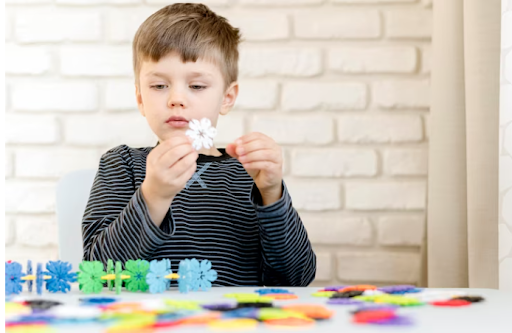Table of Contents
Children with autism suffer from stimming behaviors on a daily basis. These self-stimulatory behaviors, such as hand-flapping, rocking, or repetitive vocalizations, serve various purposes, including self-regulation and sensory stimulation.
While you may think stimming is a natural response for many individuals on the autism spectrum, excessive or disruptive stimming can pose challenges in their everyday functioning and social interactions.
To stop your child from harming themselves and lead a balanced social life, it is important that you should learn about ways to reduce these behaviors. Below in this article, we are going to explain the top 7 strategies you can follow to reduce and control stimming behaviors in your child.
1. Educate Yourself on Stimming Behaviors
Before doing anything else to help your child, you will first have to educate yourself about stimming. This way, you will be able to gain valuable insights into why children engage in these behaviors and how they can be effectively addressed.
By learning about various stimming behaviors, including hand flapping, finger flipping, and rocking, from a reliable source, you can help your child when they are going through any of these.
Furthermore, learning about the function of stimming helps you distinguish between stimming behaviors that are self-regulatory and those that may be indicative of distress or discomfort. This understanding enables you to respond appropriately and provide support accordingly.
2. Understand the Function
Stimming serves various purposes for children on the autism spectrum, such as self-regulation, sensory stimulation, or expressing emotions. By recognizing the underlying need that stimming fulfills, we can find alternative strategies that address those needs in a healthier and more functional manner.
Just remember that each child with autism is unique, and their stimming behaviors may serve different functions. For some, stimming may help them cope with sensory overload or regulate their emotions. For others, it may provide a sense of comfort and security.
By observing and analyzing the specific triggers and patterns of stimming, we can gain insights into the function it serves. Once you understand the function of stimming, you can then provide alternative outlets that fulfill those needs.
This might involve offering sensory toys or tools that provide similar sensory input or teaching self-regulation techniques that serve as healthier coping mechanisms.
3. Provide Alternative Outlets
Instead of attempting to eliminate stimming completely, it is more beneficial to redirect these behaviors towards more socially acceptable and functional activities. For example, if a child engages in hand-flapping for sensory input, offering sensory toys or fidget tools can provide a similar tactile experience.
Similarly, if your child is using stimming as a means of self-regulation, teach your child calming techniques like deep breathing or recommend the use of a stress ball to help them achieve the same goal in a more appropriate manner.
4. Offer Sensory Breaks
Sensory breaks provide a structured and intentional opportunity for children to engage in activities that fulfill their sensory needs and promote self-regulation. Create a designated space where your child can do whatever they want to calm themselves down.
During a sensory break, children can explore various sensory experiences that are soothing or stimulating to them. This can include activities like playing with sensory toys, engaging in tactile play, listening to calming music, or using sensory tools like weighted blankets or stress balls.
The key is to create a safe and designated space where the child can retreat to during overwhelming situations or when they feel the need for sensory input. These breaks not only allow children to fulfill their sensory cravings but also serve as a proactive strategy to reduce the likelihood of stimming behaviors.
By providing regular sensory breaks, children have a controlled and intentional outlet for their sensory needs, which can ultimately help them regulate their emotions and reduce the frequency or intensity of stimming.
5. Teach Self-Regulation Techniques
Self-regulation means understanding and managing your behavior. Self-regulation skills empower children to manage their emotions, sensory experiences, and behaviors in a more controlled and constructive manner.
One effective self-regulation technique is deep breathing. Teaching children to take slow, deep breaths can help calm their nervous system and reduce feelings of anxiety or overwhelm that may trigger stimming behaviors.
Encouraging them to practice deep breathing exercises during moments of stress or sensory overload can provide a healthier alternative for self-regulation.
Progressive muscle relaxation is another valuable technique. You can guide your child children through a series of muscle tensing and releasing exercises to help them become more aware of their body and release tension or anxiety. This technique promotes relaxation and self-control, which can help decrease the need for stimming.
6. Create Sensory-Friendly Environment
If you notice that your child is being sensitive to the environment around them, you can modify the surroundings to minimize sensory triggers that may contribute to stimming and promote a more comfortable and supportive atmosphere.
Creating a sensory-friendly environment involves several considerations. To start with, you can adjust the lighting to reduce harsh or flickering lights that may overwhelm the child. Softening the lighting or using natural light can create a calming ambiance.
Similarly, minimizing loud or sudden noises, such as using noise-canceling headphones or providing a quiet space, can help decrease sensory overload. Also, make sure to provide them with comfortable seating options, providing soft textures and incorporate sensory elements to offer additional sensory input that the child may seek.
This will help reduce the need for stimming behaviors, and it will be easy for you to redirect your child’s focus on anything productive.
7. Seek Professional Guidance
Healthcare professionals, therapists, or behavior specialists can provide invaluable insights and strategies tailored to the child’s specific needs. These professionals can conduct comprehensive assessments to understand the underlying factors contributing to stimming behaviors.
Also, they can help identify any co-occurring conditions, sensory sensitivities, or emotional factors that may be influencing the child’s stimming.
Ultimately, based on their expertise, professionals can develop personalized interventions and behavior plans to address stimming behaviors effectively. These plans may include a combination of strategies such as sensory integration therapy, social skills training, and individualized behavior support.









